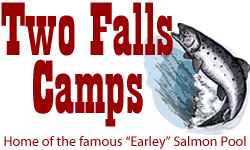How To Properly Field Dress a Whitetail Deer
We want to help you be a successful hunter when planning your next hunting trip to Two Falls Camps. One of the most underestimated parts of deer hunting is proper field dressing. You have planned your hunt, tracked the deer down and successfully bagged a beautiful whitetail deer. Now what? Well, we want to make sure you know how to field dress a deer, it’s as important as sighting your rifle. Without proper technique, you can spoil that meat that you worked so hard for, unwittingly cutting into the stomach or intestine area and ruining the spoils of your efforts.
One of the most important elements of field dressing is a sharp, hunting knife. Use a knife with at blade at least four inches long, a guard, and a large handle. For an extra level of safety, get a knife with a gutting hook. Don’t use a small pocket knife. It can turn sideways in your hand and cause damage to the meat.
Please read below to learn more about field dressing a deer and check out our handy visual aid on field dressing a deer.
IS THE DEER DEAD?
Sometimes a deer is only wounded and not dead yet. A wounded deer is dangerous. If you notice any movement, stay clear until you are sure it is dead. If you don’t detect movement after a few minutes, you can check with a stick to see if dead. Before you do, unload any cartridge from the chamber and place your rifle down. A good check is to poke the eye with a stick, no animal that is still alive will keep its eye open when poked.
START FIELD DRESSING IMMEDIATELY
The sooner the better, you want to start evacuating the heat from the carcass. Placing the animal with head elevated helps evacuate any fluids, this is a good thing (never slit the throat of a deer to bleed it out, this only make a mess).
If you happen to have shot the deer in the gut, you will want to start with cleaning that up. You don’t have to move quickly (this leads to mistakes). Move in a methodical manner and start with the correct steps to cut into the deer carcass. (Bring towels and gloves to make the process easier). Some folks think rinsing with water can lead to bacteria growth, but typically this is ok to do when you have punctured the entrails. You want to clean that up before the meat is tainted. If you don’t have water, use leaves if you have to.
Tip: If you are considering getting the head stuffed for display, stop any cutting at the rib cage. The taxidermist will need this intact.
DRAG OUT, NEVER CARRY THE CARCASS
You may think your the strong man, but save yourself the pain and always drag the deer out of the woods (but first, make sure you tagged the deer as soon as you know it’s dead, an important step). Bring rope or parachute cord and wrap it around a small tree branch (used as a handle to pull the deer). You may be miles into the woods and dragging a deer is your safest bet.
Tip: Have several bags handy for the heart and liver, and disposing of any gloves and towels used to field dress the deer. Bring rope to tow the deer as well, and of course a sharp knife. An extra you can bring is a folding saw, this can come in handy when accessing the cavity and cutting through any bones, making it safer too.

